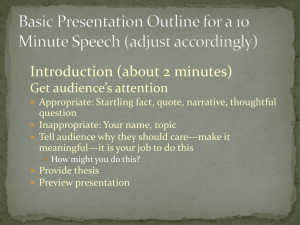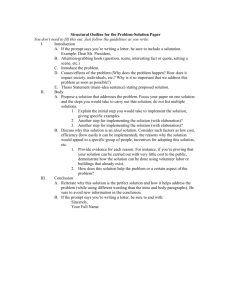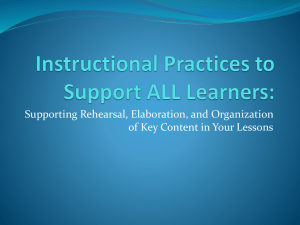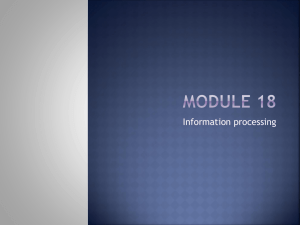Cognitive Processes PSY 334
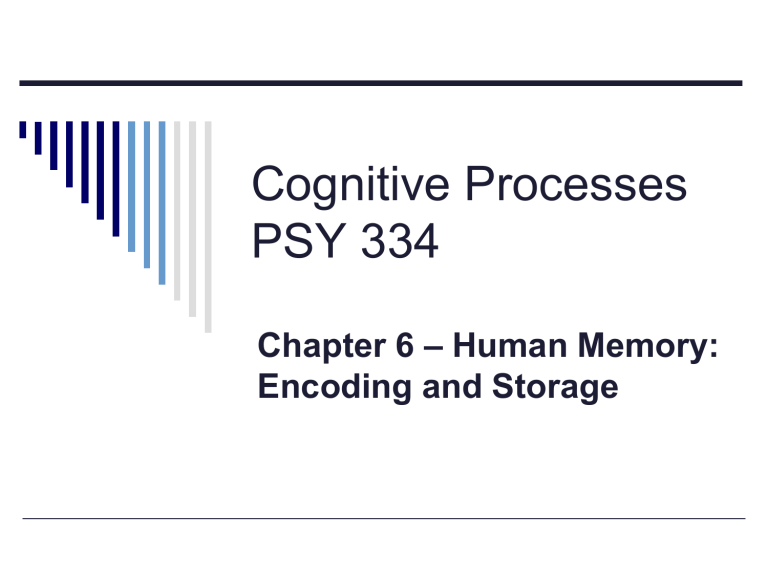
Cognitive Processes
PSY 334
Chapter 6 – Human Memory:
Encoding and Storage
Ebbinghaus
First rigorous investigation of human memory – 1885.
Taught himself nonsense syllables
DAX, BUP, LOC
Savings – the amount of time needed to relearn a list after it has already been learned and forgotten.
Forgetting function – most forgetting takes place right away.
Memory Models
Atkinson & Shiffrin – proposed a threestage model including:
Sensory store – if attended goes to STM
Short-term memory (STM) – if rehearsed goes to LTM
Long-term memory (LTM)
No longer the current view of memory.
Still presented in some books.
The Three-Stage Model
Responses
Sensation/perception
Environment
Attention
Sensory store retrieval
Short-term
(working) memory encoding
Long-term memory
Executive control processes
Retention Times
Environment Sensory store retrieval
Short-term
(working) memory encoding
Long-term memory
1-3 seconds 15-25 seconds 1 sec to a lifetime
Sensory Memory
Holds info when it first comes in.
Allows a person to extract meaning from an image or series of sounds.
Sperling’s partial report procedure:
A display of three rows of letters is presented.
After it is taken away, a tone signals which row to report.
Subjects were able to report most letters.
Sperling’s Partial Report
A medium tone signals the subject to report the letters in this row
Sperling’s Results
Delay
Kinds of Sensory Stores
Iconic memory – visual
Bright postexposure field wipes out memory after 1 sec, dark after 5 sec.
Echoic memory – auditory
Lasts up to 10 sec (measured by ERP)
Located in the sensory cortexes.
Short Term Memory
The original idea is that when info in sensory memory is paid attention to, it moves into short term memory.
With rehearsal, it then moves into long term memory.
STM has limited capacity, called memory span .
Miller’s magic number (7 ± 2)
New info pushes out older info (Shepard)
Shepard & Teghtsoonian’s
Results
Probability of recalling the target item
Number of intervening items
Criticisms of STM
Rate of forgetting seemed to be quicker than Ebbinghaus’s data, but is not really.
Amount of rehearsal appeared to be related to transfer to long-term memory.
Later it was found that the kind of rehearsal matters, not the amount.
Passive rehearsal does little to achieve long-term memory.
Information can go directly to LTM.
Depth of Processing
Craik & Lockhart – proposed that it is not how long material is rehearsed but the depth of processing that matters.
Levels of processing demo.
Working Memory
Baddeley – in working memory speed of rehearsal determines memory span.
Articulatory loop – stores whatever can be processed in a given amount of time.
Word length effect: 4.5 one-syllable words remembered compared to 2.6 long ones.
1.5 to 2 seconds material can be kept.
Visuospatial sketchpad – rehearses images
Central executive – controls other systems.
Word-Length Determines
Forgetting
Delayed Matching Task
Delayed Matching to Sample – monkey must recall where food was placed.
Monkeys with lesion to frontal cortex cannot remember food location.
Human infants can’t do it until 1 year old.
Regions of frontal cortex fire only during the delay – keeping location in mind.
Different prefrontal regions are used to remember different kinds of information.
Delayed Matching to Sample
Activation and Long-Term
Memory
Activation – how available information is to memory:
Probability of access – how likely you are to remember something.
Rate of access – how fast something can be remembered.
From moment to moment, items differ in their degree of activation in memory.
Anderson’s ACT Model
ACT – Adaptive Control of Thought
Subjects shown the word “flood” should recall Noah but do not without “Bible,”
“animal” and “flood” together.
When given the word flood they think of
Mississippi or Johnstown but not Noah.
Why? Recall is based on both baseline and activation from associated concepts.
Moses and Jesus have higher baselines.
Moses Illusion
How many animals of each species did
Moses bring onto the ark?
People respond 2 rather than none.
This occurs because people do not focus attention on who did it, and because
Moses and Noah are both Biblical characters.
This is a semantic illusion.
The ACT Model
Spreading Activation
Activation spreads along the paths of a propositional network.
Related items are faster to recall.
Associative priming – involuntary spread of activation to associated items in memory.
Kaplan’s dissertation – cues to solving riddles hidden in the environment led to faster solutions.
Associative Priming
Meyer & Schvaneveldt – spreading activation affects how quickly words are read.
Subjects judged whether pairs of related & unrelated items were words.
Judgments about related words were faster.
Meyer and Schvaneveldt
Practice and Strength
The amount of spreading activation depends on the strength of a memory.
Memory strength increases with practice.
Greater memory strength increases the likelihood of recall.
Power Function
Each time we use a memory trace, it gradually becomes a little stronger.
Power law of learning :
T = 1.40 P -0.24
T is recognition time, P is days of practice.
Linear when plotted on log-log scale.
Learning Curves
Practicing Addition Problems
Long Term Potentiation (LTP)
Neural changes may occur with practice:
Long-term potentiation (LTP) in hippocampus.
Repeated electrical stimulation of neurons leads to increased sensitivity.
LTP changes are a power function.
Neural Changes Mirror
Behavioral Changes
Neural Correlates of Encoding
Better memory occurs for items with stronger brain processing at the time of study:
Words evoking higher ERP signals are better remembered later.
Greater frontal activation with deeper processing of verbal information.
Greater activation of hippocampus with better long-term memory.
Activation in Prefrontal Cortex
Words activate left prefrontal cortex
Pictures activate right prefrontal cortex
Hemodynamic = blow flow during brain activity
Factors Influencing Memory
Study alone does not improve memory – what matters is how studying is done.
Shallow study results in little improvement.
Semantic associates (tulip-flower) better remembered than rhymes (tower-flower),
81% vs 70%.
Better retention occurs for more meaningful elaboration.
Elaborative Processing
Elaboration – embellishing an item with additional information.
Anderson & Bower – subjects added details to simple sentences:
57% recall without elaboration
72% recall with made-up details added
Self-generated elaborations are better than experimenter-generated ones.
Self-Generated Elaborations
Stein & Bransford – subjects were given
10 sentences. Four conditions:
Just the sentences alone – 4.2 adjectives
Subject generates an elaboration – 5.8
Experimenter-generated imprecise elaboration – 2.2
Experimenter-generated precise elaboration – 7.8
Precision of detail (constraint) matters, not who generates the elaboration.
Advance Organizers
PQ4R method – use questions to guide reading.
64% correct, compared to 57% (controls)
76% of relevant questions correct, 52% of non-relevant.
These study techniques work because they encourage elaboration.
Question making and question answering both improve memory for text (reviewing is better than seeing the questions first).
Meaningful Elaboration
Elaboration need not be meaningful – other sorts of elaboration also work.
Kolers compared memory for right-sideup sentences with upside-down.
Extra processing needed to read upside down may enhance memory.
Slamecka & Graf – compared generation of synonyms and rhymes. Both improved memory, but synonyms did more.
Slamecka & Graf’s Results
Mnemonics
Method of Loci – place items in a location, then take a mental walk.
Peg-word System – use peg words as a structure and associate a list of items with them using visualization.
Create acronyms for lists of items.
Convert nonsense syllables (DAX, GIB) into meaningful items by associating them with real words (e.g., DAD).
“This Old Man” Song
http://www.youtube.com/watch?v=3cYf9vkW_xU
http://www.totlol.com/watch/5d-6Q5V79CM/This-Old-Man/0/
Pegword System
1 – bun
2 – shoe
3 – tree
4 – door
5 – hive
6 – sticks
7 – heaven
8 – gate
9 – wine
10 -- hen
Incidental Learning
It does not matter whether people intend to learn something or not.
What matters is how material is processed.
Orienting tasks :
Count whether word has e or g.
Rate the pleasantness of words.
Half of subjects told they would be asked to remember words later, half not told.
No advantage to knowing ahead of time.
Awareness of Learning
Flashbulb Memories
Self-reference effect -- people have better memory for events that are important to them and close friends.
Flashbulb memories – recall of traumatic events long after the fact.
Seem vivid but can be very inaccurate, just like everyday memories.
Thatcher’s resignation:
60% memory for UK subjects, 20% non-
UK
9/11 Memories
Talairco & Rubin (2003) found that 9/11 story-consistent details decreased and inconsistent details increased with time.
Rate and amount of both kinds of details were closely similar for flashbulb & everyday memories.
Sharot et al. (2007) reported greater activity in the amygdala for people closer to ground zero, when recalling 3 yrs later
Arousal & the Self-Reference
Effect
Two explanations:
Activation of the amygdala involves a biological mechanism reinforcing memory for events important to us.
Info relevant and important to the self is rehearsed more often – resulting in better elaboration.
High arousal may enhance memory above and beyond rehearsal.
